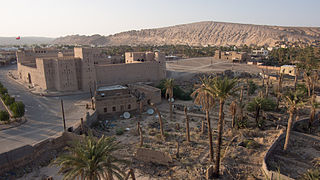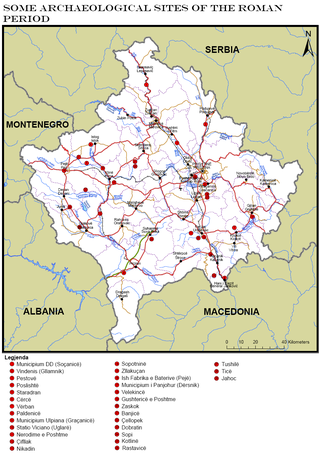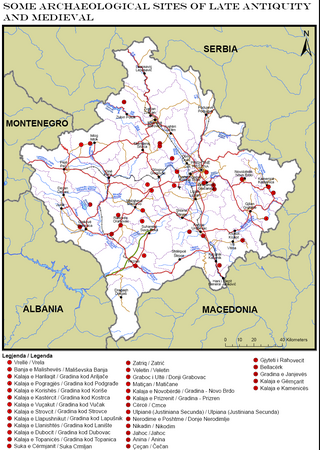
Singidunum was an ancient city which later evolved into modern Belgrade, the capital of Serbia. The name is of Celtic origin, going back to the time when the Celtic tribe Scordisci settled the area in the 3rd century BC, following the Gallic invasion of the Balkans. Later on, the Roman Republic conquered the area in 75 BC and incorporated it into the province of Moesia. It was an important fort of the Danubian Limes and Roman Legio IV Flavia Felix was garrisoned there since 86 AD. Singidunum was the birthplace of the Roman Emperor Jovian. It was sacked by Huns in 441, and by Avars and Slavs in 584. At the beginning of the 7th century, the Singidunum fort was finally destroyed.

Scupi is an archaeological site located between Zajčev Rid and the Vardar River, several kilometers from the center of modern Skopje in North Macedonia. A Roman military camp was founded here in the second century BC on the site of an older Dardanian settlement. It became later Colonia Flavia Aelia Scupi and many veteran legionnaires were settled there. A Roman town was founded in the time of Domitian and Scupi became the chief center for romanizing Dardania. It was abandoned in AD 518 during interregnum between Anastasius I Dicorus and Justin I after an earthquake destroyed the city.

Centuripe is a town and comune in the province of Enna. The city is 61 kilometres (38 mi) from Enna in the hill country between the Rivers Dittaìno and Salso.

District of Ferizaj is one of the seven districts of Kosovo. Ferizaj is the seat of the district.

Ibri is a city and Wilāyat (Province) in the Ad Dhahirah Governorate, in northwest Oman.

Ulpiana was an ancient Roman city located in what is today Kosovo. It was also named Justiniana Secunda. Ulpiana is located in the municipality of Graçanicë, 12 km southeast of Prishtinë. The Minicipium Ulpiana or Iustiniana Secunda was proclaimed an archaeological park under the permanent protection of Kosovo by the Kosova Council for Cultural Heritage in 2016. The archaeological park has an area of 161.10 hectares and a surrounding protection zone of 96.23 hectares. Ulpiana was among the largest settlements in the Balkans in late antiquity.

Prusias ad Hypium was a city in ancient Bithynia, and afterwards in the late Roman province of Honorias. In the 4th century it became a bishopric that was a suffragan of Claudiopolis in Honoriade. Before its conquest by King Prusias I of Bithynia, it was named Cierus or Kieros and belonged to the Heraclea Pontica. Photius writes that it was called Kieros, after the river which flows by it.

Municipium Dardanorum or Municipium Dardanicum was a Roman mining town whose life lasted from the 2nd to the 4th century AD, that was connected with the workings of. Its remains are situated in the northern part of Kosovo, located approximately 27 kilometres north of Mitrovica, about 65 km northeast of Ulpiana in the Municipality of Leposavic, localized in the village of Sočanica in the province of Moesia Superior, later the Roman province of Dardania.

Part of series of articles upon Archaeology of Kosovo
Part of series of articles upon Archaeology of Kosovo

The Roman heritage sites in Kosovo represent a multitude of monuments of material and spiritual culture, which reflect the Roman period in this region. Among them, a special place is occupied by those that represent the development of art, such as the plastic monuments that are more frequent, and at the same time occupy an important place, because with the presentation of figures in relief and with numerous inscriptions they speak to us enough for this period.

Part of a series of articles upon Archaeology of Kosovo

Part of a series of articles upon Archaeology of Kosovo

Part of a series of articles upon Archaeology of Kosovo
Nerodimë e Poshtme or Donje Nerodimlje is an archaeological site and village situated west of the city of Ferizaj, Kosovo. Several archaeological trenches were investigated at this location in 1988.

Idebessos or Idebessus, also known as Edebessus or Edebessos or, was an ancient city in Lycia. It was located at the foot of the Bey Mountains to the west of the Alakır river valley. Today its ruins are found a short distance to the west of the small village of Kozağacı in the Kumluca district of Antalya Province, Turkey. The site, 21 kilometres north-northwest of Kumluca, is overgrown with forest and hard to reach.
The strategic position of the region of Mitrovica in the middle of two great rivers Ibar and Sitnica and its mineral wealth in Albanik, made this location populated since prehistoric period. This region was populated by Illyrians, respectively members of the Dardan tribe. The first data for the archaeological sites in the region of Mitrovica, begin with the researches of Sir Artur John Evans, who was the first to pinpoint the Roman town of the Municipium Dardanourm. In the archaeological sites of the region of Mitrovica were found traces and objects from different periods such as; Neolithic, Roman, late antiquity and medieval period. Objects and figurines include: fortress vestiges, necropolis, Terpsichore figure, statues, sarcophagus, altar, jewelry, etc.
Kosovo has a rich heritage in archaeology, however the field suffers from a lack of substantial institutional research. Since prehistory, the advantageous geostrategic position and abundant natural resources of the area have been suitable for the emergence of life. This is shown by the traces of hundreds of archaeological sites discovered throughout the country, displaying the abundant archaeological legacy.

Archaeological Site Pionirski Park is one of the most important archaeological sites in Serbia. Protective and systematic researches of ancient Singidunum have been lasting for more than a hundred years. Unfortunately, at the beginning of the 21st century, knowledge of this city is still shallow compared to the knowledge of the history of other ancient cities that have been explored for so long. One of the reasons for this, is the fact that above the ancient Singidunum grew modern Belgrade whose construction destroyed the earlier cultural layers.

The Dardana Fortress is an archaeological site of the Bronze Age, Iron Age and late antiquity in present-day eastern Kosovo. It is located on a hill to the northwest of Kamenica. It was a hilltop settlement and fortress of the Dardani in classical antiquity. It was rebuilt in the late Roman period as part of the fortification system in the Roman province of Dardania. The site was discovered in the 1970s, but excavations did not start in earnest until 2012. One of the very earliest finds at the site is a funerary stele found accidentally at the foot of the hill in 1992. Its interpretation has helped shed light on Illyrian burial customs, and excavations at the site have contributed to knowledge about the trade patterns between Dardania and the Mediterranean region. Similar sites have been discovered in recent years in the Kamenica region.












